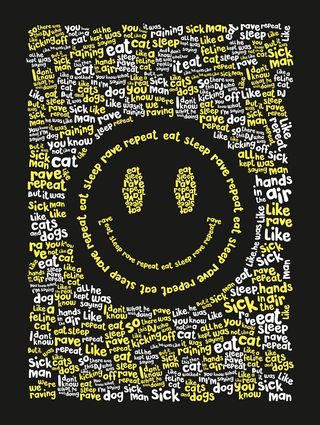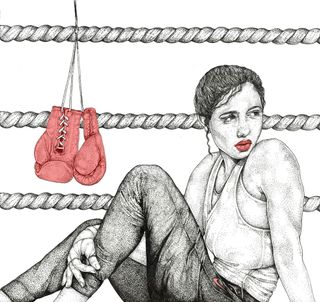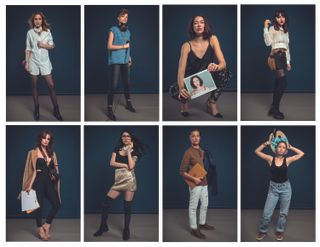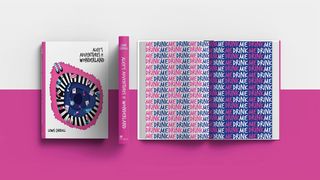A common response when telling someone you work in the creative industry is how exciting the work must be. While it of course can be, it's also really easy to get stuck in a creative rut – taking on the same kind of commissions, spending hours developing your design portfolio and having your creative freedom restricted by clients.
But work doesn't have to be like that. Yes, change can be scary, but sometimes making a brave or bold move can make all the difference to the success of your career. Question is, are you willing to try? And if not, what's stopping you?
Here are five successful creative folk with some brilliant tips on how to really push your creative career to new heights.
01. Quit your boring job

For some, having a baby might be a good reason not to leave the financial security of a full-time job. But for Sheffield-based illustrator and designer Lisa Maltby, it was actually the catalyst to do so.
She’d been working at a design agency and things had been going well, she recalls. “But I’m a real ideas and creative person, and there wasn’t a lot of opportunity to push ideas as much as I wanted to. I didn’t feel as challenged as i did when i first began.”
So just a few months after having her second child, she thought to herself: ‘Life’s too short.’ “I think kids make you feel like that,” she says. “They bring this fresh sense of life, where they’re limitless in their imaginations, and you kind of want some of that too.”
I found the initial few months gruelling, but I’m now working more flexibly and creatively than I was before
After striking out on her own, she hasn’t looked back since. "I found the initial few months gruelling to say the least, working on four hours’ sleep and going to meetings with baby puke down my back,” she says. “But I’ve since gone on to have some amazing commissions and opportunities, and I’m now working more flexibly and creatively.”
And that’s important to her psychologically as well as financially. “My creativity has always been part of my self-expression, as well as wanting it to be a career,” she stresses. “So it was almost my way of survival: that I wasn’t just knee-deep in nappies, that I had something else.”
02. Build you reputation

After five years working at design agencies across Yorkshire, people thought Amy Kilner was crazy to chuck in her job and go back to college. But the 24-year-old from Rotherham was adamant. “I'd never completed my design degree because I got a design job in my second year and left uni,” she explains. "But as I got older, I realised I needed to go back and finish it.”
She eventually did so, funding herself through a mix of student loans and freelancing. And as an unexpected by product, she ended up selling a piece of her student work to superstar DJ Fatboy Slim.
“It was a typography project for my course,” Kilner explains.“The brief was to create a poster based on song lyrics, anything we wanted. I chose the words to Eat, Sleep, Rave, Repeat. When I’d completed it, I posted it on Instagram, tagged it, and didn’t think any more about it.”
A few days later, the star’s manager emailed to ask if he could buy the illustration. Kilner agreed, and then the DJ himself emailed, requesting a signed copy to display in his home alongside artwork by Banksy, Chemical X and Jimmy Cauty. “I was like, ‘oh my goodness, this is not real!’”
It’s one of many successes she’s had since returning to education, convincing her she’s made the right decision. “I haven’t taken the normal career route,” she admits, “But it’s got me to where I am, and I’m happy.”
03. Win a dream client

Rose Waterson may have been a talented illustrator, but she wasn’t really aware of it. The fine art graduate and freelancer lacked confidence in her work, and didn’t expect to attract clients outside of her hometown of Brighton. So it was something of a surprise when she got a call from Nike.
It all stemmed from a logo and poster she had designed for a group in Brighton called Girls Can’t DJ. “They’d posted it on their Instagram account. And then later on, they’d done an interview with Nike about women in the music business,” she says.
When Nike saw Waterson’s work on the group’s Instagram, it was a case of good timing; the brand had just decided to collaborate with seven female artists to promote their new workout pants line, Nike pant Studio. So the company got in touch and commissioned her for the campaign.
I’ve realised the power Instagram has now, and the difference it can make if you invest in it
“It was about three days before the deadline,”she recalls.“They contacted me on a Monday and wanted my illustration on a Thursday. It was very last minute but I managed to do it somehow. The campaign came out about a month and a half later; the whole thing was quite swift.”
Working for Nike has raised Waterson’s profile and been a big boost to her self-confidence, she says; plus it’s taught her two main lessons. “Firstly, the importance of Instagram. I’ve always used it, but I’ve realised the power it has now, and the difference it can make if you invest in it. And secondly, you never know who your contacts are going to be. I had no idea that this DJ group had any connection to Nike, which is a bit mental if you think about it.”
04. Start a new side project

In September 2016, Ariana deLuca, an art director based in New York, was looking for a photographer. “I wanted to reach out to someone new, so I put the word out,” she recalls. “But I was getting a lot of responses from men that didn’t sit right. I didn’t feel comfortable with anyone who responded. And I thought to myself: I’d really love to work with another female creative, who has similar goals and ambitions to me. But nothing like that existed.”
DeLuca couldn’t think of an easy way to find new female creatives she didn’t already know, who were also eager to create and connect. “Then I thought: this should exist, why don’t I just make it?”
So that’s exactly what deLuca did. She got in contact with photographer and conceptual artist Heather Leigh Cullum – who she knew through a mutual friend – and in February 2017, they launched a new group for women called The passionate project. Its mission is to help ‘female creatives who want to collaborate on projects, strengthen their portfolios, and network.’
DeLuca has done all of this outside her full-time agency job, but despite the hard work and long hours, she’s loved every minute. “I think it’s great to take a risk and to open up new doors and meet people, and just help each other out,” she smiles.
People marvel at her energy and constantly ask her ‘How do you find the time?’, she says. But rather than basking in the glory, she urges others to follow her lead and pursue their own passion project.
“I just tell people: ‘you can do the same thing,’” she says. "It’s all about working hard, finding the thing you love and going forward. I try to be really encouraging and tell people to go for it. Push through those doubts and those fears, grind it out, and you’ll get there.”
05. Find the ideal work-life balance

Shanti Sparrow was working as a designer in a little boutique studio in Sydney. She enjoyed her job and found much of the work fulfilling. But something was missing, she just didn’t know what. So she decide to take a year off travelling, in order to work out what it was.
She used her savings to rent a flat in New York and stayed for six months. “When I arrived, I didn’t want to get straight into work,” she recalls. “I was so exhausted I just wanted to absorb New York, have some fun and just sleep.” Eventually she started doing bits of freelancing for her old employer. “It worked out really well for their timeline,” she notes, “because I could do it overnight, they could go to sleep and then when they woke up, it would be done.”
After half a year in the US, she then spent another six months going around Europe and Japan, visiting 17 countries in total. "It was amazing,” she smiles. "After going to Barcelona and Tokyo, I’ll never see colour in the same way again.”
I took time to focus on me. And after that, eventually, everything started to make sense
On return to Australia, though, she still struggled for a time to work out why her career wasn’t sitting right. Then, finally, it all fell into place, when she saw an ad for graphic design mentors at Shillington back in New York.
"I'd always been the mother hen of every studio I’d been at, I was always training juniors,” she explains. “And I loved the idea of still being in graphic design, but without the deadlines and clients.”
She’s now found the perfect work balance, combining a job as a lecturer for Shillington with design freelancing. And she thinks she’d never have got there without the perspective gained from travelling. “I took that time in New York to focus on me,” she explains. “And after that, eventually, everything started to make sense.”
This article originally appeared in Computer Arts issue 275; subscribe here.
Related articles:

Thank you for reading 5 articles this month* Join now for unlimited access
Enjoy your first month for just £1 / $1 / €1
*Read 5 free articles per month without a subscription

Join now for unlimited access
Try first month for just £1 / $1 / €1
Get the Creative Bloq Newsletter
Daily design news, reviews, how-tos and more, as picked by the editors.

Tom May is an award-winning journalist and editor specialising in design, photography and technology. Author of the Amazon #1 bestseller Great TED Talks: Creativity, published by Pavilion Books, Tom was previously editor of Professional Photography magazine, associate editor at Creative Bloq, and deputy editor at net magazine. Today, he is a regular contributor to Creative Bloq and its sister sites Digital Camera World, T3.com and Tech Radar. He also writes for Creative Boom and works on content marketing projects.